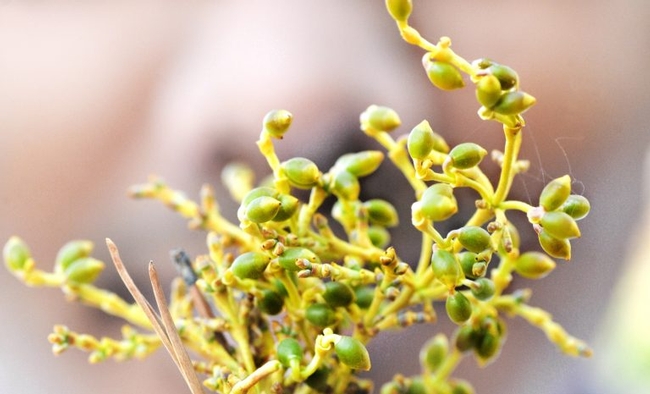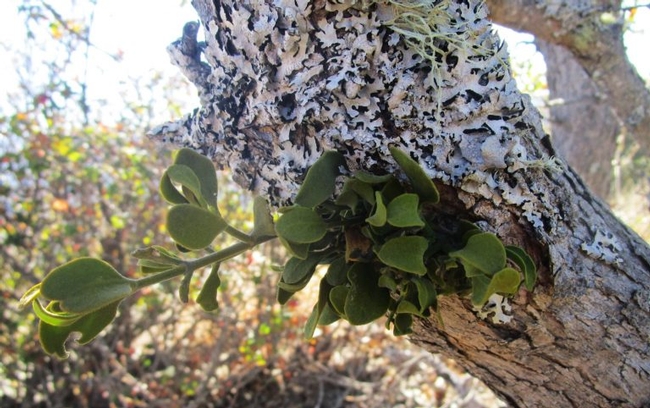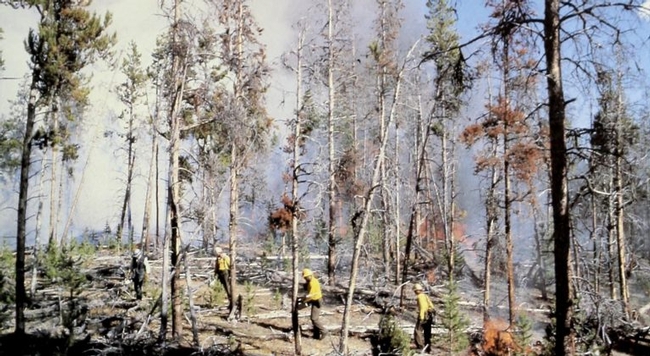To see dwarf mistletoe seeds is to experience them. These are not typical seeds that gently drop from a mature plant. Rather, they are explosive — forcibly ejected from their fruits at high rates of speed. I remember learning about this in college: that dwarf mistletoe seeds can travel up to 60 mph and fly more than 60 feet from their hosts (Hinds et al., 1963). This process is triggered by internal heat production (called thermogenesis) within the mistletoe fruit — something that's never been observed in another plant (Rolena et al., 2015). It wasn't until many years after college that I actually experienced the phenomenon for myself. I remember driving along the Trinity River here in northern California and seeing a sudden splattering of little gelatinous green balls all over my windshield. I still remember how excited I was when I realized what they were: seeds that had flown as fast as I was driving.

Dwarf mistletoe fruits. Credit: Thompson Rivers University shared via Flickr Creative Commons.
It turns out that the seeds are only one of many intriguing things about mistletoe. There are more than 1,300 species of mistletoe; they grow all over the world (on all continents except Antarctica!); they support and interact with wildlife in all kinds of neat ways (Watson, 2001); and they are part of human culture and tradition (even evoking a kissing response in some!). And yet they're parasitic — not usually our favorite type of organism. More specifically, they're hemi-parasitic, meaning that they obtain all of their water and minerals from their host plant, but have some ability to provide for themselves. For example, leafy mistletoe, which is common in oaks where I live, is fully photosynthetic and therefore has a limited impact on its host trees. Dwarf mistletoe is a more demanding guest, requiring water, minerals and other nutrients, and taking a much greater toll on the many species of plants that it inhabits.

Leafy mistletoe is fully photosynthetic and therefore has a limited impact on its host trees. Credit: Dan Kidwell shared via Flickr Creative Commons.
As a major forest pathogen, dwarf mistletoe has a strong and well-studied connection to fire. Studies conducted in the 1970s clearly noted the relationship, pointing to fire suppression as the primary driver of increasing dwarf mistletoe abundance in many North American forests (Alexander and Hawksworth, 1975). At that time, dwarf mistletoe was recognized as one of the most damaging pathogens in many important forest types, and its impacts on the timber industry — with estimated losses of 3.2 billion board feet annually (Shea and Howard, 1969) — spurred quite a bit of research into its ecology and potential control tactics. Wildfire and prescribed fire naturally emerged as focal points for research, and those topics have continued to lure researchers, just as dwarf mistletoe has continued to wreak havoc. In a 2008 paper, Paul Hessburg and others argued that due to its wide distribution and habitat versatility, “dwarf mistletoes are probably responsible for more tree growth and mortality losses each year than all other forest pathogens combined.”
Like most forest pests and diseases, the relationship between fire and dwarf mistletoe is a two-way street: mistletoe affects fire, and fire affects mistletoe. For example, research has shown that mistletoe-infested stands of ponderosa pine have higher snag densities and higher fuel loads than uninfested stands, and that infested stands have higher crown fire potential (Hoffman et al., 2007). Mistletoe also has a number of tree-level effects that increase flammability and fire behavior potential, including the establishment of witches' brooms (dense, twiggy growth around areas of infection) and resinous stem cankers (Alexander and Hawksworth, 1975). Other research has documented reduced self-pruning and stunted growth in infected trees, both of which effectively lower the height of the live crown and thereby increase the potential for torching and canopy fire (Conklin and Geils, 2008).
The effects of mistletoe on fire behavior are fairly intuitive, but I find the effects of fire on mistletoe to be a little more intriguing. For instance, a study by Zimmerman and Laven tested the effect of smoke on the seed germination of three species of dwarf mistletoe, and they found that smoke exposure can reduce germination or prevent it altogether (when exposure exceeds 60 minutes) (1987). Earlier work by Koonce and Roth had also indicated that heat and smoke might have a disproportionate effect on dwarf mistletoe compared with their effects on the host plant (1980). Other studies have looked at the sanitizing effect that fire can have on mistletoe-infected trees. Conklin and Geils studied ponderosa pine stands in New Mexico, and they observed reductions in the dwarf mistletoe rating (DMR) — a categorical system for assessing infection (Hawksworth, 1977) — in 12 of 14 frequently burned plots (2008). This sanitizing effect was associated with average tree scorch above 25 percent, and it points to the potential utility of prescribed fire for dwarf mistletoe management, assuming that fire intensity is able to meet these minimum “scorch pruning” thresholds. Hessburg et al. also found that thinning and burning could be effective treatments for dwarf mistletoe in ponderosa and Douglas-fir forests, but that treatments would have to be implemented on regular intervals, as effects diminished after 20 years (2008).

Foresters using prescribed fire to treat mistletoe infestations in the 1970s. Credit: U.S. Department of Agriculture shared via Flickr Creative Commons.
Of course, the relationship between fire and mistletoe — and the approach to fire-based treatments — is highly dependent on the fire regime of the specific forest type in question. Much of the literature on dwarf mistletoe and fire comes out of frequent-fire forests like ponderosa pine and western mixed conifer, but lodgepole pine and black spruce are also common hosts, and their fire regimes are much different. In those types of forests, which are adapted to less frequent, more severe fire regimes, stand-replacing fire may be important for protecting future cohorts of trees from infection. Research in Rocky Mountain lodgepole pine forests showed that the time elapsed since the last stand-replacing fire was a good predictor of mistletoe infestation, and that the presence of remnant infected trees increased rates of infestation in younger, post-fire stands (Kipfmueller and Baker, 1998). In these forest types, the authors suggest that effective prescribed fire treatments would need to be intense and stand replacing.
I've always thought that mistletoe was interesting, but working on this blog opened a whole can of unexpected worms. Who knew that it was mistletoe, with its many interesting wildlife synergies, that inspired Charles Darwin to study evolution (Watson 2001)? Or that the term “mistletoe” is an ancient reference to some mistletoe species' reliance on seed dispersal by birds, who eat the seeds then deposit them on tree branches — the name comes from “misteltan,” an Anglo-Saxon word meaning “dung twig” (!!). Mistletoe has also been used by humans to bait deer for hunting (the foliage is quite tasty!); to treat infertility, syphilis, bubonic plague, epilepsy and other ailments; and to celebrate the return of summer, which mistletoe hints at with its evergreen foliage (Paine and Harrison, 1992). So with this blog, I celebrate mistletoe — i.e., dung twig, kissing plant, ballistic seeder, fire friend and foe — as quite possibly the coolest plant ever!
The Fire Adapted Communities Learning Network publishes blogs on a weekly basis. Subscribe to have more stories like this delivered to your inbox.
References cited:
Alexander, M. E., & Hawksworth, F. G. (1975). Wildland fires and dwarf mistletoes: a literature review of ecology and prescribed burning (Vol. 14). Rocky Mountain Forest and Range Experiment Station, Forest Service, US Department of Agriculture.
Hawksworth, F. G. (1977). The 6-class dwarf mistletoe rating system. The 6-class dwarf mistletoe rating system., (RM-48).
Hinds, T., Hawksworth, F. & McGinnies, W. Seed discharge in Arceuthobium: a photographic study. Science 140, 1236–1238 (1963).
Hoffman, C., Mathiasen, R., & Sieg, C. H. Dwarf mistletoe effects on fuel loadings in ponderosa pine forests in northern Arizona. Canadian Journal of Forest Research, 37, 662-670.
Kipfmueller, K. F., & Baker, W. L. (1998). Fires and dwarf mistletoe in a Rocky Mountain lodgepole pine ecosystem. Forest ecology and management, 108(1-2), 77-84.
Koonce, A. L., & Roth, L. F. (1980, April). The effects of prescribed burning on dwarf mistletoe in ponderosa pine. In Proceedings of the Sixth Conference on Fire and Forest Meteorology, Seattle, Wash (pp. 22-24).
Paine, L. K., & Harrison, H. C. (1992). Mistletoe: its role in horticulture and human life. HortTechnology, 2(3), 324-330.
Rolena, A. J., Paetkau, M., Ross, K. A., Godfrey, D. V., & Friedman, C. R. (2015). Thermogenesis-triggered seed dispersal in dwarf mistletoe. Nature communications, 6, 6262.
Shea, K. R., & Howard, B. (1969). Dwarf mistletoe control; a program for research and development in the West. West Forest Conserv Assoc West Reforest Coord Comm Proc.
Watson, D. M. (2001). Mistletoe—a keystone resource in forests and woodlands worldwide. Annual Review of Ecology and Systematics, 32(1), 219-249.
Zimmerman, G. T., & Laven, R. D. (1987). Effects of forest fuel smoke on dwarf mistletoe seed germination. The Great Basin Naturalist, 652-659.